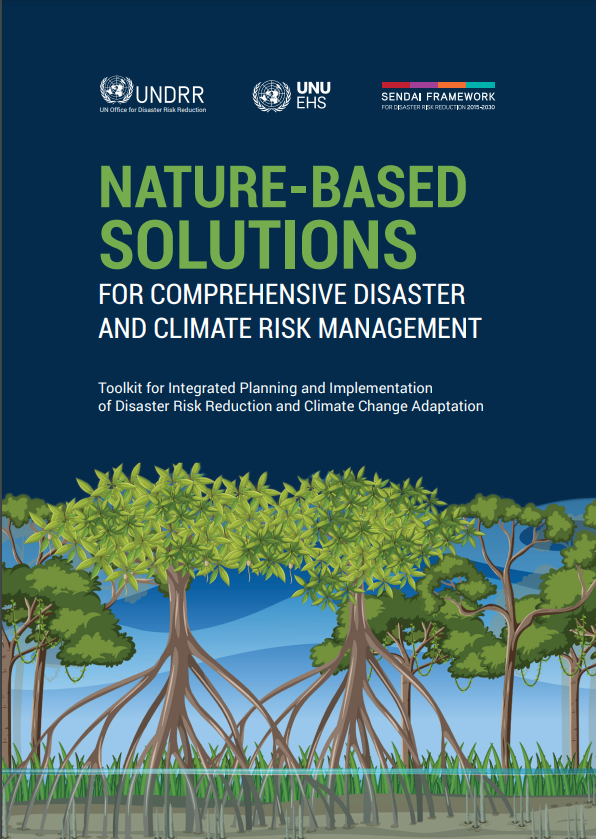
Nature-Based Solutions for Comprehensive Disaster and Climate Risk Management: Key Tenets and Recommendations
Abstract
This article examines the “Nature-Based Solutions for Comprehensive Disaster and Climate Risk Management” toolkit developed by the United Nations Office for Disaster Risk Reduction (UNDRR). The toolkit aims to support countries in integrating nature-based solutions (NbS) into comprehensive disaster risk management (CRM) and climate change adaptation (CCA). The article explores the key tenets of the toolkit, including its theoretical foundations, methodological approaches, and practical applications. Recommendations for effective implementation and policy integration are also discussed.
Introduction
The increasing frequency and intensity of natural disasters and climate change impacts necessitate innovative approaches to disaster risk reduction (DRR) and climate change adaptation (CCA). Nature-based solutions (NbS) offer a promising pathway, integrating natural processes and ecosystem services into risk management strategies. The UNDRR’s toolkit provides a structured approach to incorporating NbS into CRM, aligning with international frameworks like the Sendai Framework for Disaster Risk Reduction and the United Nations Environment Assembly’s (UNEA) definition of NbS.
Key Tenets of the Toolkit
- Integrated Planning and Policy CoherenceThe toolkit emphasizes the integration of NbS into national and subnational policies, facilitating coherent planning across DRR and CCA strategies. This alignment promotes a unified approach to managing risks and enhances policy coherence (UNDRR, 2023).
- Stakeholder Engagement and Inclusive GovernanceEffective NbS implementation requires active participation from diverse stakeholders, including local communities, indigenous peoples, and various sectors. The toolkit provides guidelines for inclusive governance, ensuring that all relevant actors are involved in the planning and decision-making processes (UNDRR, 2023).
- Context-Specific Risk AssessmentThe toolkit’s methodological approach begins with a comprehensive assessment of a country’s environmental, climatic, and socio-economic context. This includes evaluating hazards, exposure, and vulnerabilities to identify specific entry points for NbS (UNDRR, 2023).
- Selection and Customization of NbS InterventionsTailoring NbS interventions to local contexts is crucial for their success. The toolkit offers guidance on selecting appropriate NbS measures, considering various ecosystems and climate-related hazards. It also highlights the co-benefits of NbS, such as biodiversity conservation and livelihood enhancement (UNDRR, 2023).
Methodological Approaches
- Data Compilation and AnalysisThe toolkit provides tools for compiling and analyzing data on environmental factors, climate variables, hazards, and vulnerabilities. This information forms the basis for informed decision-making and strategic planning (UNDRR, 2023).
- Keyword-Based Policy ReviewA comprehensive list of NbS-related keywords helps identify existing references to NbS in national policies and plans. This review process ensures that new initiatives build on existing efforts and leverage current knowledge (UNDRR, 2023).
- Case Studies and ExamplesThe toolkit includes case studies demonstrating successful NbS implementations, offering practical insights and lessons learned. These examples serve as models for other countries to adapt and replicate (UNDRR, 2023).
Practical Applications
- Flood Management through Wetland RestorationOne notable example from the toolkit is the use of wetland restoration for flood management. Restoring and reconnecting rivers to floodplains can mitigate flood risks, enhance water quality, and provide habitat for biodiversity (UNDRR, 2023).
- Coastal Protection with Mangrove ReforestationCoastal areas benefit significantly from mangrove reforestation, which acts as a natural barrier against storm surges and erosion. Mangroves also sequester carbon and support fisheries, contributing to climate mitigation and local economies (UNDRR, 2023).
- Community-Based Adaptation in BangladeshThe toolkit highlights a community-based adaptation project in Bangladesh, where mangrove and wetland restoration have reduced climate vulnerability and supported sustainable livelihoods. This project underscores the importance of local engagement and capacity-building (UNDRR, 2023).
Recommendations for Effective Implementation
- Strengthening Institutional FrameworksTo facilitate NbS integration, countries should strengthen institutional frameworks that support cross-sectoral collaboration and policy coherence. Establishing dedicated NbS units or task forces can enhance coordination and implementation.
- Capacity Building and Knowledge SharingBuilding the capacity of local stakeholders and practitioners is crucial for successful NbS implementation. Training programs, workshops, and knowledge-sharing platforms can enhance technical skills and promote best practices.
- Securing Sustainable FundingLong-term funding mechanisms are essential to sustain NbS initiatives. Countries should explore diverse financing options, including public-private partnerships, international grants, and climate finance instruments.
- Monitoring and EvaluationEstablishing robust monitoring and evaluation frameworks is vital to assess the effectiveness of NbS interventions. Regular assessments can inform adaptive management and ensure that NbS continue to deliver desired outcomes.
Conclusion
The UNDRR’s toolkit for integrating nature-based solutions into comprehensive disaster and climate risk management offers a valuable resource for countries seeking to enhance resilience through sustainable practices. By emphasizing integrated planning, stakeholder engagement, and context-specific interventions, the toolkit provides a robust framework for leveraging natural ecosystems in risk management. Implementing the recommendations outlined in this article can further strengthen NbS adoption and contribute to global efforts in disaster risk reduction and climate change adaptation.
References
UNDRR. (2023). Nature-based Solutions for Comprehensive Disaster and Climate Risk Management. United Nations Office for Disaster Risk Reduction.



